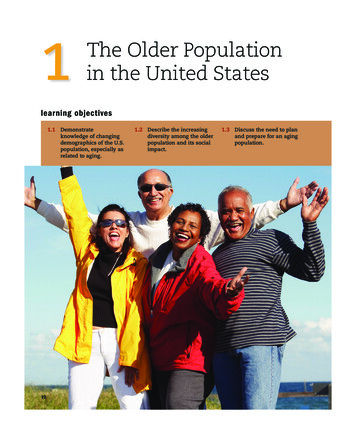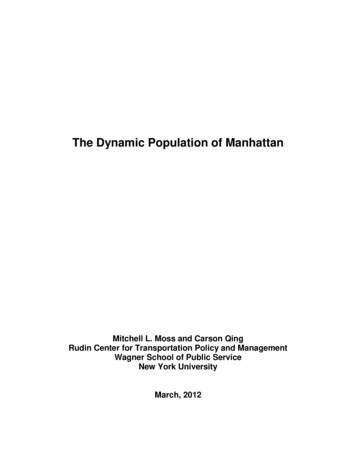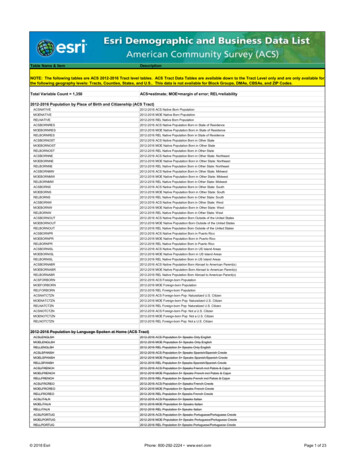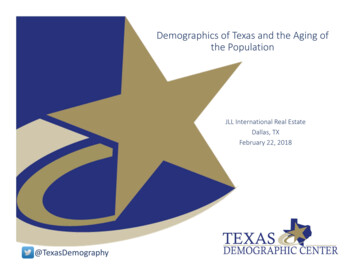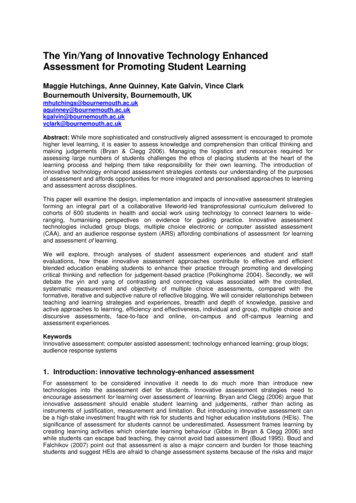
Transcription
SC/65a/BRG27SC/65a/BRGPopulation Assessment of the Sakhalin Gray Whale AggregationJustin G. Cooke1,2, David W. Weller3, Amanda L. Bradford4, Olya Sychenko5, Alexander M. Burdin5and Robert L. Brownell, Jr.3ABSTRACTA population assessment of the Sakhalin feeding aggregation of gray whales (Eschrichtius robustus) wasconducted using photo-identification data collected on their summer feeding ground off Sakhalin Island from1994 to 2011, fitted to an individually-based population model. This is an update of the assessments byReeves et al (2005) and Cooke et al. (2006; 2008). For this assessment, the model has been extended toincorporate the following additional factors: individual heterogeneity in sampling probability; time lags in theeffects of environmental variability on population parameters; an explicit age-specific maturation ogive; andimmigration. As in previous assessments, the sampling probability is found to be significantly stagedependent and is lowest for immature animals. Allowing, additionally, for individual heterogeneity insampling probability results in a very substantial improvement in model fit but has only a small effect onestimates of population size and demographic parameters. There is found to be significant inter-annualvariability in both calving rates and “calf” survival rates, but no evidence of net trend in these parameters.For these data, “calf” survival represents survival from the first summer season ( 6-8mo age) to the secondsummer season ( 18-20 mo age). The best fit to the data is obtained by introducing a 2-year time lag in thecorrelation between calving rates and calf survival rates: i.e. a low (high) calf survival rate from year t to yeart 1 tends to be associated with a low (high) calving rate in year t 2. There is little evidence for immigration:the level of immigration is estimated to be zero or negligible in recent years, but immigration early in theperiod cannot be excluded. Estimates of key population parameters from the best-fitting model are 0.975 ( E0.005) for the non-calf annual survival rate; 0.67 ( 0.07) for the average calf survival rate; 11.5 yr ( 1.1 yr)for the mean age at first parturition. 3.3% per annum ( 0.5%) for the estimated realised average annual rateof population increase over the last 10 years (2002-2012); 140 ( 6) whales for the 1 (non-calf) populationsize in 2012 and 36 ( 2) mature females in 2012. These estimates are insensitive to the choice of model.Forward projections of the population model to 2020, assuming no additional mortality or deterioration inenvironmental conditions, indicate a high probability ( 95%) of continued population increase. The resultssuggest that the Sakhalin feeding aggregation has been demographically self-contained, at least in recentyears, in the sense that the only new recruits are calves born to mothers within the group, even though taggingresults show that Sakhalin gray whales migrate to common gray whale breeding grounds in the eastern NorthPacific.1. INTRODUCTIONGray whales (Eschrichtius robustus) have been regularly reported during the summer months (June to October) offnortheastern Sakhalin Island since the early 1980’s (Brownell et al. 1997) and have been intensively studied there since1997 (Burdin et al. 2013). Initially the Sakhalin gray whales were assumed to be a remnant of the western gray whalepopulation formerly hunted in Korean and southern Japanese waters until the 1960s. The timing of gray whales catches inthe Korean grounds was suggestive of a migration to a wintering ground in Asian waters. However, a whale (“Flex”)tagged off Sakhalin in 2010 was followed to the waters of Oregon State, USA (Mate et al. 2011). Further tagging resultsand photo-id and genetic matches have shown that (at least some of) the Sakhalin gray whales migrate to breeding groundsin Mexican waters along with the bulk of the eastern North Pacific gray whale population (Weller et al. 2012). Whether agray whale breeding ground in Asian waters still exists, and if so, whether any whales seen off Sakhalin migrate to an Asian1Institute for Terrestrial and Aquatic Wildlife Research, Werftstr. 6, 25761 Büsum, GermanyCEMS, Höllenbergstr. 7, 79312 Windenreute, Germany. Email: jgc@cems.deProtected Resources Division, Southwest Fisheries Science Center, National Marine Fisheries Service, National Oceanicand Atmospheric Administration, 3333 North Torrey Pines Court, La Jolla, CA, 92037-1022 USA4Protected Species Division, Pacific Islands Fisheries Science Center, National Marine Fisheries Service, NationalOceanic and Atmospheric Administration, Honolulu, HI, USA5Kamchatka Branch of Pacific Institute of Geography, Russian Academy of Sciences, Far East Division, Petropavlovsk, Kamchatka 683000, Russia231
breeding ground is, at the time of writing, unknown but cannot be excluded on current evidence (Weller and Brownell,2012).An ongoing annual summer photo-identification study was initiated in 1995 as part of the Marine Mammal Project underArea V: Protection of Nature and the Organization of Reserves within the Russia-U.S. Agreement on Cooperation in theField of Environmental Protection,. This study has been continued since 2009 by the Kamchatka Branch of the PacificInstitute of Geography (Burdin et al. 2013). The photo-identification data (supplemented by genetic sex determinationsfrom biopsies) from this study are used in this paper to conduct a population assessment.A parallel vessel-based photo-id study sponsored by the petroleum industry has been conducted off Sakhalin since 2002 bythe Institute of Marine Biology, Vladivostok (Tyurneva et al 2013). Individuals identified off Sakhalin in both these studieshave also been identified off eastern Kamchatka in summer (Tjurneva et al 2013) and in Mexican waters in winter (Welleret al. 2012; Urbán et al. 2012).On the assumption that Sakhalin whales constituted a separate population, Reeves et al. (2005) conducted a populationassessment using photo-id data collected through 2003. This assessment was subsequently updated by Cooke et al. (2006and 2008).The model developed by Reeves et al. was an individually-based model in which each individual in each year is in a givenstage (such as calves, immature whales of various ages, adult males, calving females and resting females). The transitionprobabilities between stages, and their variation over time, are modelled and estimated. The model was fitted to the photoid data in an annual capture-recapture framework, where capture (i.e. photo-sampling) probabilities vary over time andbetween stages. It was used to estimate population size, survival, reproductive and population growth rates, and to projectthe population forward under various scenarios.For this analysis, the model has been developed further to incorporate the following additional processes: individual heterogeneity in sampling probability (in addition to the stage-specific differences) time lags in the effects of environmental variability on population parameters; an explicit age-specific maturation ogive (to improve estimation of the mean age at first reproduction) ; immigration (i.e. the possibility for new whales to enter the aggregation in addition to those born to mothers withinthe group)The latter issue is potentially important for the question of whether the Sakhalin whales constitute a demographically selfcontained group and whether they should be managed as a unit, despite sharing breeding grounds with other gray whales.2. MATERIAL AND METHODS2.1. Photoidentification and sex-determination dataPhoto-identification data have been collected in the summer season (June to September) in the Piltun area of north-easternSakhalin by the joint Russia-US programme from 1997 to the present, with some data also collected in 1994 and 1995.Since 2009 the programme has been continued by the Kamchatka branch of the Pacific Geography Institute (Burdin et al.2013). Data from the seasons up to and including 2011 were available for this analysis. A total of 205 distinct individualwhales had been catalogued as of 2011. The catalogue has been published and annually updated since 2006 (Weller et al.2006).Calves of the year (age approx 6-9 months, assuming births occur during December-January) were identified as such usingthe criteria specified by Bradford (2009). Associations between mothers and calves were recorded. Many of the cataloguedwhales have also been biopsied, enabling their sex to be determined genetically, and for apparent mother-calf relationshipsto be cross-checked genetically.The following information on each identified whale was used for this analysis:- the year first seen, and whether first seen as an accompanied calf, as an unaccompanied calf, or as a non-calf;- the subsequent years in which the individual was seen, and the subset of years in which it was seen with a calf;- sex, where known (determined genetically from biopsies)Genetic sex determinations from biopsy were available for 141 whales (58 females and 83 males) for this analysis,including all but one of the whales seen with an accompanying calf. Further biopsy samples are awaiting analysis.A total of 101 calves have been identified. Of these calves, 87 could be linked to an identified mother (in all but one caseby observed association, the remaining case genetically). Of the 101 observed calves, 63 have been sexed genetically: 22female and 41 male. Of these 63 calves, 54 were biopsied in the year that they were a calf : 18 female and 36 male.2
While the observed sex ratio of non-calves may be subject to an availability bias, we assume that calves of each sex areequally available and that the sex ratio of calves, when sampled as calves, reflects the true sex ratio amongst calves. Thesex ratio of these 54 calves is significantly biassed towards males (χ² 6.0; d.f. 1; p 0.01). Therefore, we included thesex ratio of calves as a parameter in the model, instead of assuming that was 50:50.Twenty-nine (29) individual females, have been observed with a calf. Two of these had originally been observed as calvesand are hence of known age (age 9 and 10 respectively).A total of 58 apparent inter-birth intervals have been observed, including 31 two-year intervals, 16 three-year intervals, 5four-year intervals, and 6 longer intervals. Because no 1-year intervals were observed, we assume that all 2- and 3-yearintervals were real inter-calf intervals, but that intervals of 4-years or longer may in some cases have spanned missedcalvings.The parallel vessel-based photo-id programme has been conducted off Sakhalin since 2002 by the Institute of MarineBiology had, of 2011, also identified 205 distinct individuals. A comparison of the two photo-id catalogues showed that187 whales were common to both catalogues (IUCN, 2013). These data were not used in this analysis (but see furthercomments in the Discussion).2.2. Population modelThe population model is an individually-based stage-structured population model with stages and their transitions shown inFig. 1. The model is discrete time with a time step of one year.The breeding females are divided into three stages: pregnant, lactating, and resting. Females are assumed not to besimultaneously pregnant and lactating. A female can become pregnant immediately following lactation , resulting in a 2year calving interval (the minimum observed). Optionally, a female can enter the resting phase for one or more years,resulting in a 3-year or longer calving interval.These stages are to be interpreted schematically rather than literally. “Lactating” females include all females that lactated inthe given year: some may have already have weaned their calf if encountered later in the season. The “Pregnant” stageincludes only those whales which will actually give birth and bring a live calf to the feeding ground the following summer.Pregnancies which fail or where the calf is lost before arrival on the summer feeding grounds cannot be separately identifiedby the data used and are subsumed into the “Resting” stage. The age at first pregnancy is assumed to range from 7 to 12years (i.e. first calving from 8 to 12 years of age).Males are arbitrarily placed into an “adult” class from age 8. The adult males play no explicit role in this model. There areassumed to be more than enough males available for mating, and furthermore the females are under no obligation to choosea mate from within the Sakhalin population. The only reason for separating adult from immature males in the model is toallow the model to account for the differential availability of immature and adult animals in the study area.The basic version of the model contains a total of 24 living stages: calves (2 stages); immature males (7 stages); adult males(1 stage); immature females (11 stages); and adult females (3 stages). In addition, there is an unborn stage and a deadstage, making a total of 26 stages.Where there are multiple options for transition to the next stage, these are modelled as successive binary choices, startingwith the choice survive/not survive. The probability p for the first option in each binary choice is modelled as a logitfunction p ez/(1 ez) of a linear predictor z. The model for z contains, in each case, an intercept term plus zero or moreoptional factors as indicated below. The probability for the second option in the binary choice is 1 – p.Transition to the dead stage (not shown in Fig. 1.) represents mortality. If any permanent emigration occurs, this would besubsumed into the mortality rate as far as this model is concerned. There is no explicit transition probability form the unbornstage to a calf stage. Births are treated as a life choice of the mother, not of the calf. For each birth, the mother selects anunborn animal randomly from an inexhaustible pool of unborns. Sex is assigned randomly at birth: the sex ratio at birth is aparameter of the model.Individual (as opposed to stage-related) heterogeneity in sampling probability is modelled by assigning each individual withequal probability to one of three availability strata: low, medium and high. The sampling probability is allowed to bestratum-dependent. While each individual has an equal prior probability of belonging to each stratum, the posteriorprobabilities that a given individual belongs to each of the three strata will depend on the data. When such heterogeneity isincluded, there are 3 24 live stages, to make a total of 74 stages.The model parameters and the factors on which they depend (or may depend) are summarised in Table 1.3
Table 1. Models used for each parameterCore terms in linearmodelTransition probabilitiesFromFemale aged a (j 6, ., 11)LactatingRestingSurvival probabilitiesCalvesOthersOther parametersSex ratio at birthSampling probabilityInitial population sizeImmigrationSex ratio of immigrantsWeaned probabilityToPregnantPregnantPregnantfemale proportionfemale proportionOptional termsintercept; age erceptyearyearinterceptintercept; yearinterceptintercept; year (linear)interceptinterceptstage group; availability classThe year effect in each case is modelled as a series of annual random effects, plus (optionally) a linear trend.The transition probabilities to the pregnant state are referred to loosely as calving probabilities, because in this model thepregnant state includes only successful pregnanciesImmigration is optionally allowed. An “immigrant” is defined as an individual whose mother was not a member of thepopulation. The number of immigrants is assumed to follow a Poisson distribution with an exponential trend. Immigrantsare assumed to be immature animals. The sex ratio of immigrants is a parameter of the model.To complete the model, we require a means to specify the initial numbers in each stage at the start of the modelled period.To reduce the sensitivity of the results to the initial conditions, we start the model in 1980, well before the first data in 1994.We take the 1980 population size (total across live stages) as a parameter to be estimated, while the stage distribution in1980 is drawn randomly with replacement from the stable stage distribution implied by the deterministic version of themodel (with all random effects set to zero). Sensitivity tests showed that taking the initial year further back had negligibleeffect on the results.2.3. Sampling modelAn animal is ‘sampled’ in a given year when it is photographed in that year, and the photographs have been processed andassigned to an existing known whale in the catalogue, or to a new whale which is added to the cataloguet.The sampling probability includes a year effect (to account for varying research effort over time), and, optionally, a stageeffect and an “availability stratum” effect.For the stage effect, the stages are grouped as follows: calves; immature animals; ‘adult’ males; lactating females; pregnantand resting females.To allow for the fact that some lactating females of the year have already separated from their calf when encountered, a‘weaned probability’ parameter, w, is included in the model to represent that probability that mother and calf have separatedbefore they are first encountered in the season. Letting pL and pC denote the sampling probabilities for lactating females andunaccompanied calves in a given year and stratum: the probability that a lactating whale and its calf will be seen together is:wpL ; the probability that a calf will be seen alone is wpC ; and the total probability that the calf will be seen in that year is:(1 w) pL wpC .The data consist of the matrix of sampling histories H, where an entry Hlt denotes the sampling result for history l in year t.The sampling result of each history in each year takes one of the following five values: (0) not seen; (1) mother with calf;(2) accompanied calf; (3) unaccompanied calf; (4) other whale. Each sighting history has an associated sex datum that takesone of three values: male; female; or unknown. The index l runs from 0 through n, where 0 denotes the null history(animals which have never been seen, and which remain unknown) and observed histories 1 through n where n is thenumber of individuals in the photo-id catalogue. The index t runs across all years for which there are data (they are notnecessarily consecutive).4
The sampling model enables us to calculate the array P(j,t,k) of probabilities that an animal in stage j in year t will havesampling result k.2.4. Fitting the model2.4.1 Maximum likelihood estimationEach individual in the population (whether observed or not) has a (hypothetical) biography, which consists of the true stageof the individual in each year. In the matrix of biographies, the entry Bit refers to the stage of biography i in year t.Using the array P from sampling model of the previous section, we calculate the matrix Q defined by:Qi l P( Bit, t, Hl t )twhere each entry contains the probability that an individual with biography i gets a sampling history l. The index i rangesover the set of all possible biographies.Given an expression for bi, the prior probability (given the population model and parameters, prior to the fit to the data) forbiography i, the likelihood of sighting history l is given by:Ll bQi iilWe avoid calculating explicitly the probability of all possible biographies (there would be too many), and instead use thestandard forward-backwards algorithm for Markovian state space models. This obtains mathematically the same result bysequentially evaluating the posterior probability distribution of the stage probability distribution for each individual in eachyear.The overall likelihood of the data is customarily taken as the product of the likelihoods of the individual histories. Strictlyspeaking, this is not a correct procedure because births are occurring and some known individuals were born from otherknown individuals. Thus, even if the sampling of each individual is independent, the production of each individual is not.Any potential biasses arising from ignoring this dependence are overcome in the sampling of the Bayesian posteriordistribution as described in the next section.The overall log likelihood is taken as the sum of the sampling histories log likelihood and the residual log likelihood of therandom effects, if any. The AIC (Akaike Information Criterion) is used for model comparison and selection. The effectivenumber of parameters for the purpose of calculating the AIC is fractional when random effects are included.Estimation standard errors for basic model parameters were determined from the variance-covariance matrix obtained byinverting the Hessian matrix at the point of best fit. Estimation standard errors for functions of model parameters wereestimated using the linear approximation: f f var( f (p)) V(p) p p Twhere p is the vector of basic parameters and V is its variance-covariance matrix. For parameters subject to annual randomeffects, the process variance (sigma) of functions of the parameter is estimated using the linear approximation: ˆ f ( p) df dp ˆ pwhere σp is the process variance (sigma) of the parameter p.2.4.2. Estimation of the Bayesian posterior distributionOnce a model has been selected using AIC, the Bayesian posterior distribution of simulations of the population can besampled. For this purpose, the population model is simulated explicitly on an individual basis, including all births anddeaths. The dependence between individual biographies mentioned above is thereby automatically accounted for. Themaximum likelihood estimates, obtained as described in the previous section, are used here only as an aid to efficientsampling of the posterior: the likelihood of each simulation is calculated separately. Each simulation was started in 1980and run forward to 2020. Percentiles of key population parameters were generated.For all parameters representing probabilities (survival and transition probabilities, and sex ratios), the prior distribution wastaken to be uniform U(0,1). For all random effect variances, the prior distribution of log σ² was taken to be normal N(0,1).5
Prior distributions for positive quantities (initial population size and immigration rate) were taken as uniform on a log scale(improper priors). Priors for trends were taken as normal N(0,1) after scaling to the length of the data series. Trends inparameters were not extrapolated beyond the data series.3. ResultsTable 2 shows the results of fitting various models in a sequential process, along with estimates of selected parameters ofinterest. The estimates of population parameters shown in Table 2 are fairly insensitive to the choice of model, especiallyonce heterogeneity has been accounted for.Case 1 represents the minimal reasonable model. The inclusion of stage-specific availability factors (case 2) substantiallyimproves the fit (ΔAIC 15.6) and was therefore retained in all subsequent cases. Inclusion of individual heterogeneityin availability (case 3) further substantially improved the fit (ΔAIC 61.0) and was retained in all subsequent cases.Allowing variability in the calving rate (case 4) results in a further significant improvement in fit (ΔAIC 10.1) and isretained in subsequent cases. Allowing, additionally, for independent variability in “calf” survival rate (case 5) producesonly a modest improvement in fit (ΔAIC 2.7). Having the two parameters vary in unison (through sharing the samesequence of annual random effects) (case 6) substantially worsens the fit relative to either keeping calf mortality constant orallowing it to vary independently (ΔAIC 7.3 and 10.0 respectively). However, the fit is considerably improved if weintroduce a time lag in the correlation between calving rates and calf survival rate. The best-fitting time lag is 2 years (case8) (ΔAIC 16.4 relative to no time lag (case 6), or 6.4 relative to no correlation (case 5)). Other time lags fit less wellthan 2yr lag, although a 3yr lag is less strongly rejected (ΔAIC 2.8 relative to a 2yr lag) than other lags. Even if weadjust the AIC by 2 to allow for the fact that we are in effect treating the time lag as an additional parameter, the resultsstill strongly reject both the unison and uncorrelated models relative to a 2yr lag. The 2yr lag was retained in subsequentfits. Allowing, additionally, an overall trend in the annual effects (case 11) does not improve the fit (ΔAIC 0.1).Allowing for immigration (case 12) produced a slight improvement in fit (ΔAIC 1.9). However the estimates ofimmigration by year (Fig. 2b) show that immigration has been zero or negligible in recent years. For the earlier years, thedata are consistent with immigration ranging from zero to a level comparable to the number of calves. It is in the nature ofphoto-id data that they cannot exclude immigration in the early years of a study, because new whales of all ages areencountered in the early years with no means to determine their origin. Because the results indicate that immigration hasbeen zero or negligible at least over the most recent 10 years, and the evidence for earlier immigration is weak, we selectboth case 8 (no immigration) and case 12 (with immigration) into the shortlist of preferred models.Estimates of further parameters of interest with their standard errors, and where applicable, their process standard deviationsare listed in Table 3 for the two preferred models. The results show that the estimation errors are less than the processstandard deviations where the latter can be estimated: the remaining uncertainty is therefore be dominated by the lattervariance.Figs 2a-b shows the estimated historical time trends from 1994 to 2012 of four population components of interest: calves;immigrants (where applicable); mature females and the total age 1 population (i.e. the non-calf population, includingmature females).Figs 3a-b show various percentiles of the population trajectories of the 1 and mature female population size from a sampleof 1,000 simulations of the Bayesian posterior distribution of population simulations, projected forward to 2020, for the case(a) without immigration and (b) with immigration. Although there is estimated to be no immigration in recent times,allowing for the possibility of earlier immigration slightly increases the uncertainty in future projections, because it reducesthe precision of estimates of population parameters, and ascribes some of the strong apparent growth in the early years toimmigration. However in both cases there is a high ( 95%) estimated probability of continued population increase forwardto 2020.4. DiscussionThe results show that there is substantial heterogeneity in detection probability, both stage-related and individual-related,but it has a relatively minor impact on parameter estimates. There is compelling evidence of annual variability in bothpregnancy and calf survival rates, and that these are correlated with a time lag of 2 years. The evidence is against anysignificant immigration in recent years, but is neutral to, or weakly in favour of, some immigration in earlier years. Theestimate of “adult” (non-calf) annual survival rate at 0.975 ( 0.005) implies a mortality rate of 0.025( 0.5) . Since thisparameter would reflect any permanent immigration in addition to actual mortality, its value implies that the extent ofemigration, if any, is small.The finding that variations in “calf” survival rate (from the first to the second summer season, i.e. between about age 8-18months) and calving rates are correlated with a 2-yr time lag may throw light on the question of when in the reproductiveprocess the impacts of external factors are most strongly felt. The 2yr lag implies that when calf survival from summer 20xx6
to 20xx 1 is low, calf production, as recorded in summer 20xx 2 tends also to be low. It may be that if feeding conditionsare poor in summer 20xx, calves of the year have trouble surviving to 20xx 1, and also that the mother switches from a 2yrto a 3yr breeding cycle, so that her next calf is “born” in 20xx 3 instead of in 20xx 2. (Note: we define the birth year as theyear of the January: a calf born in December 20xx is assigned a birth year of 20xx 1). Analysis of the correlation betweenthese parameters and time series of ecological factors know to affect gray whale survival and/or reproduction could throwfurther light on the question.The estimates of small or zero immigration levels in recent years suggest that the Sakhalin gray whale population isdemographically self-contained, in the sense that new entrants are almost exclusively calves of mothers from within thepopulation.However, the population is known, as a result of tagging, photo-identification matches and genetic matches, to sharebreeding grounds in the eastern North Pacific with other gray whales (Weller et al. 2012). These findings are not mutuallyinconsistent if there is a high degree of maternally directed feeding site fidelity. Such fidelity would also be broadlyconsistent with genetic information which shows a lower level of haplotypic diversity among Sakhalin whales (with 95 outof 142 animals belonging to just 2 haplotypes) than in North Pacific gray whales as a whole (Lang et al. 2011). TheSakhalin population is estimated in this assessment to have contained only 30 4 age 1 females in 1994. Projecting backthe observed growth rates to the end of commercial whaling for gray whales in the mid-1960s would imply a possiblebottleneck population of less than 10 females. The presence of greater haplotypic diversity among males (Lang et al. 2011)could suggest that, if immigration has occurred, it was predominantly of males .Given its apparent demographic discreteness, the Sakhalin population may continue to merit treatment as a managementunit or “unit to conserve” as defined by the IWC Subcommittee on Stock Definition (Jackson and Pampouille, 2012). Giventhe current estimate of 3
1 SC/65a/BRG _ Population Assessment of the Sakhalin Gray Whale Aggregation Justin G. Cooke1,2, David W. Weller3, Amanda L. Bradford4, Olya Sychenko 5, Alexander M. Burdin5 and Robert L. Brownell, Jr.3 ABSTRACT A population assessment of the Sakhalin feeding aggregation of gray whales (Eschrichtius robustus) was conducted using photo-identification da ta collected on their summer feeding .



